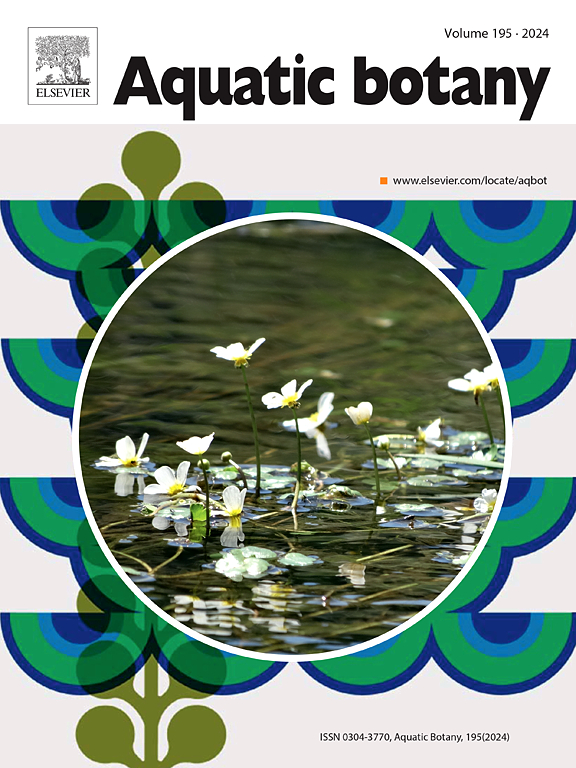Preliminary assessment of a nutrient pollution indicator for application to tropical seagrasses of Puerto Rico
IF 2.6
4区 生物学
Q2 MARINE & FRESHWATER BIOLOGY
引用次数: 0
Abstract
Seagrass health is often used as an indicator of water quality and plant tissue nitrogen content has long been used as an indicator of nitrogen availability, but it is not a sensitive early indicator of nutrient over enrichment. A critical characteristic for an early indicator is that it can detect increased nutrient availability before seagrasses die. The seagrass nutrient pollution indicator (NPI) integrates leaf tissue nitrogen content and leaf areal mass to track nutrient loading. We assess the underlying assumptions associated with the NPI metric and explore the application of the metric to three tropical seagrasses Thalassia testudinum, Halodule wrightii, and Halophila stipulacea. In June 2022 we sampled ten seagrass sites across three embayments in Puerto Rico. We used water column and sediment nutrient measurements, seagrass stable isotope analyses (%N and δ15N) and we made morphological measurements (leaf areal mass, mg dry weight cm −2) to evaluate the NPI relative to anticipated environmental gradients. T. testudinum sheath material, H. wrightii and H. stipulacea met the assumptions of the NPI method, suggesting that the NPI metric may be applied to these tropical species. Jobos Bay sites had isotopically light δ15N values suggesting that either local N fixation or import of allochthonous N fixation are dominant sources. In Guánica Bay, heavy δ15N values suggest either wastewater inputs or internal recycling of N are the dominant source. Additional research is required, but the evidence suggests that with further development and validation the NPI metric with δ15N could be appropriate for tropical seagrass species.
波多黎各热带海草营养物污染指标的初步评价
海草健康状况常被用作水质指标,植物组织氮含量长期被用作氮有效性指标,但它不是养分过度富集的敏感早期指标。早期指标的一个关键特征是,它可以在海草死亡之前检测到营养供应的增加。海草养分污染指标(NPI)综合了叶片组织氮含量和叶片面积质量来跟踪养分负荷。我们评估了与NPI度量相关的基本假设,并探索了该度量在三种热带海草(海草)上的应用。海草包括:海草(Thalassia testudinum)、白盐藻(Halodule wrightii)和托叶盐藻(Halophila tolacea)。2022年6月,我们在波多黎各的三个海湾取样了10个海草地点。我们使用水柱和沉积物养分测量、海草稳定同位素分析(%N和δ15N)以及形态学测量(叶面积质量,mg干重cm - 2)来评估相对于预期环境梯度的NPI。剑齿苋鞘材、白花剑齿苋和托马剑齿苋满足NPI方法的假设,表明NPI度量可以应用于这些热带物种。Jobos Bay遗址的δ15N同位素值较轻,表明本地固氮或外来固氮是主要来源。在Guánica湾,重δ15N值表明废水输入或内部循环是N的主要来源。虽然还需要进一步的研究,但有证据表明,随着进一步的开发和验证,δ15N的NPI度量可能适用于热带海草物种。
本文章由计算机程序翻译,如有差异,请以英文原文为准。
求助全文
约1分钟内获得全文
求助全文
来源期刊

Aquatic Botany
生物-海洋与淡水生物学
CiteScore
3.80
自引率
5.60%
发文量
70
审稿时长
6 months
期刊介绍:
Aquatic Botany offers a platform for papers relevant to a broad international readership on fundamental and applied aspects of marine and freshwater macroscopic plants in a context of ecology or environmental biology. This includes molecular, biochemical and physiological aspects of macroscopic aquatic plants as well as the classification, structure, function, dynamics and ecological interactions in plant-dominated aquatic communities and ecosystems. It is an outlet for papers dealing with research on the consequences of disturbance and stressors (e.g. environmental fluctuations and climate change, pollution, grazing and pathogens), use and management of aquatic plants (plant production and decomposition, commercial harvest, plant control) and the conservation of aquatic plant communities (breeding, transplantation and restoration). Specialized publications on certain rare taxa or papers on aquatic macroscopic plants from under-represented regions in the world can also find their place, subject to editor evaluation. Studies on fungi or microalgae will remain outside the scope of Aquatic Botany.
 求助内容:
求助内容: 应助结果提醒方式:
应助结果提醒方式:


